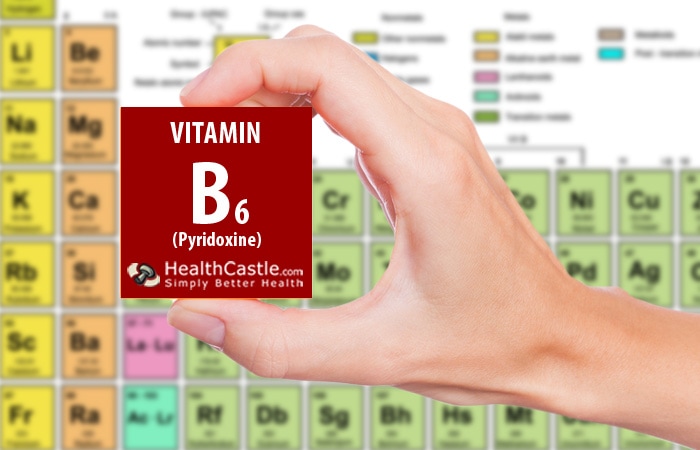
Written By: Carolyn Berry, RD
Title: Registered Dietitian
Alumni: University of British Columbia
Last Updated on:

Vitamin B6 is one of eight B vitamins. All of the B vitamins are water soluble, meaning that the body does not store them but excretes them in the urine.
Table of Contents
The Dietary Reference Intakes (DRI) for Vitamin B6 are shown below:
| Age Group | Recommended Dietary Allowance (RDA) per Day1 | Tolerable Upper Intake Level (UL) per Day2 |
| Adults | ||
| 19 to 50 years | 1.3 mg | 100 mg |
| 51 years and up | 1.7 mg male 1.5 mg female | 100 mg |
| Kids and Youth | ||
| 1 to 3 years | 0.5 mg | 30 mg |
| 4 to 8 years | 0.6 mg | 40 mg |
| 9 to 13 years | 1.0 mg | 60 mg |
| 14 to 18 years | 1.3 mg male 1.5 mg female | 80 mg |
| Special Considerations | ||
| Pregnant women 14 years and up | 1.9 mg | No upper limit established |
| Lactating women 14 years and up | 2.0 mg | No upper limit established |

Like the other B vitamins, Vitamin B6’s main role is to help your body use carbohydrates and protein to make energy3. Your body needs Vitamin B6 for more than 100 enzyme reactions involved in metabolism. Some of these reactions include the breakdown of fatty acids and gluconeogenesis, and the release of glucose from glycogen, which in turn helps to maintain normal blood sugar levels. B-complex vitamins are also needed for healthy skin, hair, eyes, and liver, and they help the nervous system4 to function properly.
Vitamin B6, along with Vitamin B12 and folate, helps maintain normal levels of homocysteine in the blood5. Homocysteine is an amino acid that when found in high levels in the blood may be associated with heart disease. Taking Vitamin B6 supplements in combination with other B vitamins has been shown to be effective for lowering homocysteine levels. It is not clear if lowering homocysteine levels directly causes a reduction in cardiovascular morbidity and mortality.
Vitamin B6 helps the body synthesize several neurotransmitters, chemicals that carry signals from one nerve cell to another. These neurotransmitters are needed for normal brain development and function. B6 also helps the body make the hormones serotonin and norepinephrine, which influence mood, emotions, sleep patterns and appetite; and melatonin, which regulates sleep and wake cycles.
Vitamin B6 helps prevent anemia6 by playing a part in iron transport and metabolism. Specifically, it helps form hemoglobin, which carries oxygen in your blood.
Research has shown that Vitamin B6 supplements may play an important role in decreasing nausea and vomiting during pregnancy and reducing premenstrual syndrome symptoms7. Furthermore, studies show that people with low levels of Vitamin B6 in the blood might have a higher risk of certain types of cancer, such as colorectal cancer, and that elderly people who have higher blood levels of Vitamin B6 have better memory. However, the results of these studies are currently inconclusive.
The best sources of Vitamin B6 include meat, poultry, organ meats, fish, enriched cereals, nuts, meatless soy products, lentils, and some fruits and vegetables.
| Food | Vitamin B6 per serving |
| Cereal, All Bran, 1 cup | 7.4 mg |
| Tuna, yellowfin, cooked, 3 oz | 0.88 mg |
| Soy-based vegetarian meat, 3 oz | 0.8 mg |
| Liver (turkey), cooked, 3 oz | 0.8 mg |
| Liver (chicken), cooked, 3 oz | 0.68 mg |
| Salmon, sockeye, cooked, 3 oz | 0.59 mg |
| Tuna, canned, 1 can | 0.53 mg |
| Venison, various cuts, cooked, 3 oz | 0.52 mg |
| Sunflower seeds, shelled, 1/4 cup | 0.47 mg |
| Banana, 1 medium | 0.43 mg |
| Chicken breast, boneless and skinless, 3 oz | 0.37 mg |
| Oatmeal, instant, cooked, 1 packet | 0.37 mg |
| Wheat bran, 1/2 cup | 0.35 mg |
| Trout, cooked | 0.29 mg |
| Lentils, cooked, 3/4 cup | 0.26 mg |
| Potato, with skin, baked, 1/2 cup | 0.23 mg |
| Bell pepper, raw, chopped, 1/2 cup | 0.22 mg |
| Chickpeas, cooked, 3/4 cup | 0.17 mg |
In the United States: The daily value for Vitamin B6 is 1.7 mg8. The % daily value gives you an idea of how much Vitamin B6 is in the food you eat. The number you see on the Nutrition Facts label is a percentage calculated by dividing the amount of Vitamin B6 in one serving of the food by the daily value. However, the FDA does not require that the % daily value for Vitamin B6 be written on the Nutrition Facts label.
In Canada: The daily value for Vitamin B6 is 1.7 mg9, which is slightly higher than the RDA for adults. Listing the daily value for Vitamin B6 on the Nutrition Facts label is optional.
Niacin: Vitamin B6 assists in the formation of niacin from tryptophan.
Vitamin B12: Vitamin B6 is needed for Vitamin B12 absorption.
HealthCastle has strict sourcing guidelines. We reference peer-reviewed studies, scientific journals and associations. We only use quality, credible sources to ensure content accuracy and integrity.
Alumni: University of British Columbia – Carolyn Berry is a Vancouver-based Registered Dietitian, self-proclaimed foodie, marathon runner, and owner of Berry Nourished. Carolyn works in a variety of areas including clinical nutrition, outpatient counselling at Medisys Preventive Health Clinic, as a nutrition tour leader with Save-On-Foods, and in the media, including segments on CBC Television, CKNW and Spice Radio. Through informative and practical nutrition advice and her food-first approach to health, Carolyn fulfills her passion to empower others with knowledge about nutrition so that they can make the best decisions to improve their health. She strongly believes that food should be both healthful and delicious.
micronutrient - vitamins, vitamin B6, vitamins
Herbal Supplements and Prescription Drugs: Interactions to Watch Out For